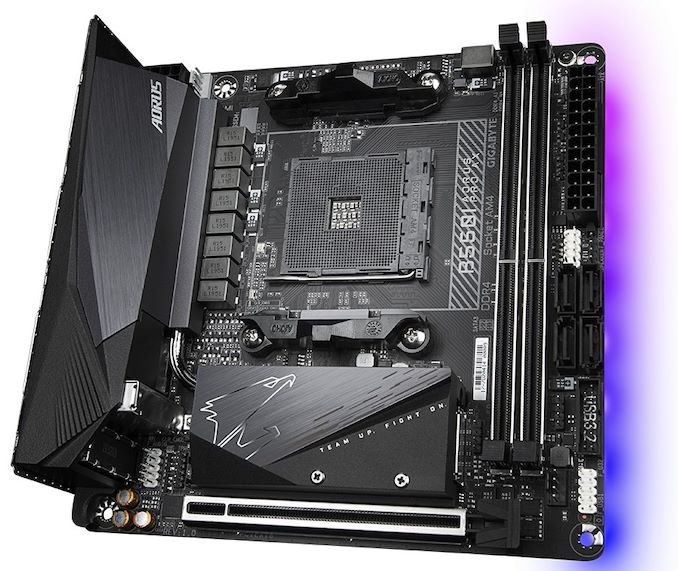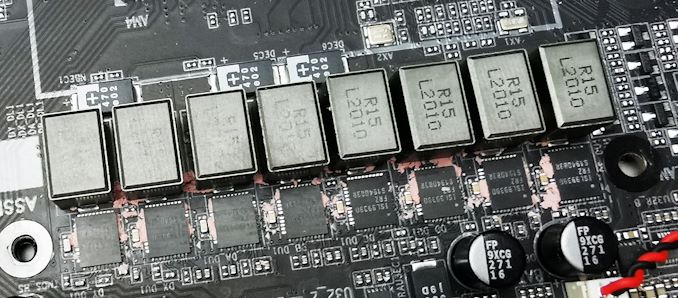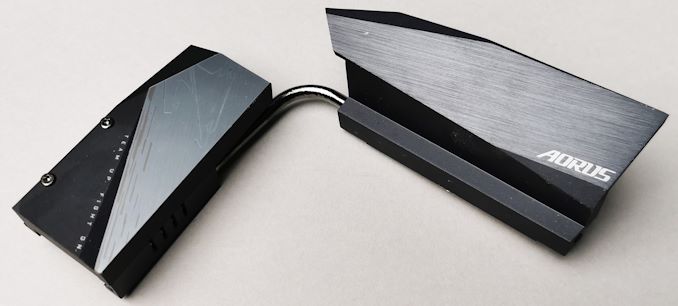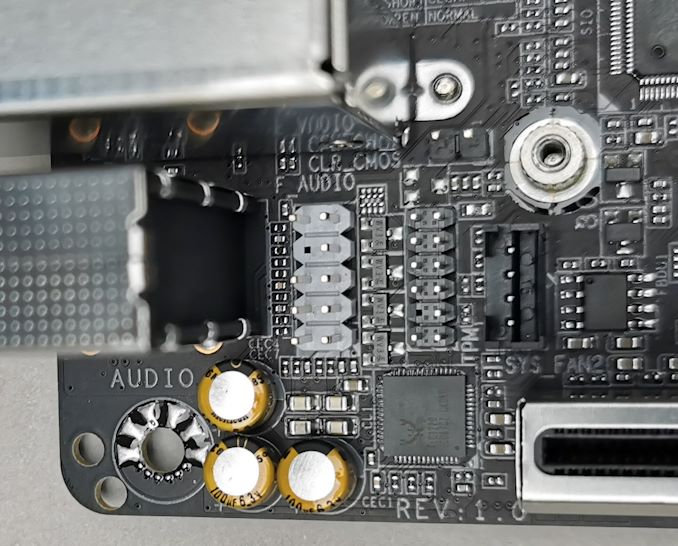The GIGABYTE B550I Aorus Pro AX Motherboard Review: All The Small Things
by Gavin Bonshor on December 7, 2020 10:00 AM ESTVisual Inspection
Looking very closely at the GIGABYTE B550I Aorus Pro AX motherboard, it has a small but capable frame with a very neutral aesthetic. It employs a primarily black and grey design, with a silver combined chipset and front-mounted M.2 heatsink, with one section of RGB LED lighting, which lights up the board's underside along the right. For users looking to add a little more pizazz, GIGABYTE includes an addressable and regular RGB LED strip pairing compatible with a lot of different RGB ecosystems, including Corsair's iCUE and NZXT CAM. However, GIGABYTE has its own called RGB Fusion 2.0.
Despite being mini-ITX, the GIGABYTE B550I Aorus Pro AX has plenty to focus on. Looking at expansion support, there is a single full-length PCIe 4.0 x16 slot, with the capability to install up to one PCIe 4.0 x4 M.2 slot on the front of the board, with a second slot on the rear of the PCB with support for both PCIe 3.0 x4 and SATA drives. There are four SATA ports for SATA devices, which are all straight angled and sit directly below the 24-pin ATX 12 V power input. These SATA ports do include support for RAID 0, 1, and 10 arrays, and they don't share bandwidth with any of the M.2 slots, even when SATA based M.2 drives are installed.
Users familiar with the mini-ITX form factor can appreciate that there will be limitations in connectivity, both internal and external. One of these is prevalent in its support for cooling, with just three 4-pin fan headers available on the B550I Aorus Pro AX model. One of these is dedicated to a CPU fan, while the other two are for chassis fans, although AIO pumps are supported through all three headers.
Memory compatibility looks strong with GIGABYTE's official support for up to DDR4-5100 memory, with a total capacity of up to 64 GB. Both of the memory slots and the full-length PCIe 4.0 x16 slot come with PCIe armor, designed to reinforce the slot to avoid physical damage to the slots when installing hardware. This also gives the slots better structure for heavier components such as NVIDIA's latest RTX 3090 graphics card, which is notoriously large and bulky.
For the power delivery, GIGABYTE is using an 8-phase design, which is being controlled by a Renesas RAA229004 PWM controller. The configuration is split into a 6+2 configuration, with six premium Intersil ISL99390 90 A power stages for the CPU and two ISL99390 90 A power stages for the SoC. On paper, this is one of the most capable mini-ITX models from the B550 models in regards to maximum power output to the CPU, with a maximum output of up to 540 A for the CPU. Delivering power to the CPU is a single 8-pin 12V ATX power connector.
The power delivery heatsink is interconnected to the M.2 and chipset heatsink, a common theme on mini-ITX models. It doesn't include finned heatsinks, so it relies primarily on mass, although the heatsink's top will catch airflow within a chassis. Unlike the X570 variant, there is no cooling fan above the chipset heatsink, which is a plus as it should be more than adequate without one.
The GIGABYTE B550I Aorus Pro AX is using a simplistic yet premium audio setup. It includes three Japanese Nichicon gold audio capacitors, with the driving being done by a Realtek ALC1220-VB HD audio codec. This is cramped in directly next to the end of the full-length PCIe slot, with no EMI shielding and no visible audio PCB segregation. There is also a front panel audio header, which is also powered by the ALC1220HD codec, although it is in this funny little position. This might interfere with the backplates on some of the larger graphics cards.
For a small board such as this one, it has an acceptable amount of connectivity on the rear panel, which is largely down to space restrictions. Starting with USB, the B550I Aorus Pro AX makes use of two USB 3.2 G2 ports, one Type-A, and one Type-C, with four additional USB 3.2 G1 Type-A ports. While this in itself isn't a lot, GIGABYTE does include a USB 3.2 G1 and USB 2.0 front panel heading pairing, which each allows a further four ports (two each) to be added to the system. The networking configuration is premium, with a Realtek RTL8125 2.5 GbE port, with two antenna ports for the Intel AX200 interface with Wi-Fi 6 and BT 5.0 support. Three 3.5 mm audio jacks are driven by a Realtek ALC1220-VB HD audio codec, while a trifecta of video outputs consisting of two HDMI 2.1 and a DisplayPort allows users to utilize the Ryzen 4000 APU's. Finishing off the rear panel is a Q-Flash Plus button.
















76 Comments
View All Comments
meacupla - Tuesday, December 8, 2020 - link
yup, that's exactly what happens.The only remaining fix I could think of was replacing the soldered in BIOS chips
star-affinity - Tuesday, December 15, 2020 - link
Just wanted to say that my problems was resolved with a new power supply! So now the Gigabyte motherboard is working fine again, believe it or not. :)duploxxx - Tuesday, December 8, 2020 - link
not to mention cold boot - bios resets - unable to save q-fan profiles etc...I was very impressed by the x370 although it lacked some easy visual design.
The x570 gigabyte is not worth the money, would stay away from it as much as possible.
I also own an Asrock B450 board, a much better bios layout.
Dug - Tuesday, December 8, 2020 - link
Strange. I have Gigabyte going back to p965 with no issue.No issue with my x570 aorus pro wifi like you describe either, like thousands of others.
kkilobyte - Tuesday, December 8, 2020 - link
I - and others - have zero idea on what is triggering the issue. There is clearly something fishy going on with the power distribution on the Aorus X570, but so far, it was not possible to pinpoint the origin of it. ErP, USB load, PSU, DisplayPort, Sleep modes, RAM modules all have been suspected, but none of those elements led to anything conclusive. There is a +20 pages thread on hardforum.com about it. I tried to probe the issue with my scope, but it happens completely randomly; so far, it happened to me 3 times in about 8 months, and last time it happened, I was in a hurry and couldn't test.Doing a CMOS reset through the jumper doesn't solve the issue; it could thus mean that it is not a cmos-ram corruption, but a more fundamental electrical issue. My best bet is that somehow a power spike at shutdown is sometimes high enough to wrongly toggle a signal line that 'locks' one of the components kept alive by the battery.
Finding the solution would require identifying the components that are kept powered by the cmos battery; without precise motherboard schematics, however, that's going to be difficult; even if it gets identified, I don't see how it would be solved without some sort of hardware hacking.
My personal solution is to design an arduino-based circuit that plugs on the battery connector of the motherboard, and allows a 'reset' through a front panel button. It's less than ideal, but that's better than having to open the case and remove my gfx card just to get the battery out.
mkarwin - Tuesday, December 15, 2020 - link
Well if CMOS reset does not fix the issue there's either a failing BIOS chip or circuitry throughout the board's layers... Theoretically one could pinpoint the issue by replacing the BIOS chip...BTW. I honestly wonder why they haven't thought of putting BIOS(es) on microSD cards, some of those smaller ones would be dirt cheap nowadays and capacituous enough to handle modern UEFI BIOSes - easy to remove/replace/reflash, could maybe improve the consumer attitude towards the issue if it is related to BIOS chips...
hansip87 - Monday, December 7, 2020 - link
What i don't understand with AMD mini ITX board is how few are their USB ports available at the back. one of the reasons why i chose going intel route was that there is this cheap Asrock Z490 itx board with 8 USB ports at the back. Sure it;s not the only factor but why can't any of AMD ITX boards do the same?romrunning - Monday, December 7, 2020 - link
Well, you can always just get a plug-in USB hub if you need more. I think the mfgs don't add as many USB ports mostly as a cost-savings.mkarwin - Tuesday, December 15, 2020 - link
Seems quite odd considering they are still asking more ($) for less (size & features)... It's not like they're running out of space on I/O shield, there's no integrated massive cooling openings in most cases, so adding eg. 4 extra even 2.0 USB ports would be more beneficial than having 3 display outputs for the integrated Radeon solutions... I could see a future where more integrated display outputs is beneficial - if they allow adding those server/compute accelerators without display outputs so that they could pass through the display to those board integrated ports. Otherwise, I think maybe 1 HDMI is enough. Especially if you can use said HDMI to pass through audio from the integrated card as well...jeremyshaw - Monday, December 7, 2020 - link
Probably the massive AMD AM4 keep out area. It doesn't really matter for mATX and ATX, but for mITX, every mm^2 matters. But every B550 ITX board is flawed in some way.ASUS hates rear I/O altogether, ASRock ditches the S/PDIF and doesn't have all that many USB ports (still more than ASUS). Gigabyte's never head of USB-C headers, and MSI gets all of that right, but has a proprietary backplate.
X570 came out a year earlier and is worse in many ways. ASUS is pricing their top end board for people without sense, and all of the X570 mITX boards from all other vendors lack the USB-C header. All of them are also 1GbE only, which seems like a waste for such a fast platform. ASRock has TB3, but only one M.2 slot, and very few USB ports.
In the end, I've held off upgrading my old AB350 Fata1ity ITX, since nothing is really appealing w.r.t. upgrading (not to mention almost twice the price!). Ryzen 5000 might force my hand, but I'd still rather not "upgrade" to boards that are very flawed (IMO) vs their Intel counterparts.
On Intel, all is not perfect, but there are more "perfect" boards that don't have these same issues.